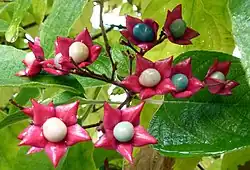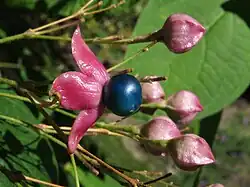Clerodendrum trichotomum
| Clerodendrum trichotomum | |
|---|---|

| |
| Scientific classification | |
| Kingdom: | Plantae |
| Clade: | Tracheophytes |
| Clade: | Angiosperms |
| Clade: | Eudicots |
| Clade: | Asterids |
| Order: | Lamiales |
| Family: | Lamiaceae |
| Genus: | Clerodendrum |
| Species: | C. trichotomum
|
| Binomial name | |
| Clerodendrum trichotomum | |
Clerodendrum trichotomum, the harlequin glorybower, glorytree or peanut butter tree,[2] is a species of flowering plant in the family Lamiaceae. It is native to China, Korea, Taiwan, Japan, India, and the Philippines.[3][4]
It is cultivated for its fragrant flowers, autumn color, and ornamental berries, which contain the novel blue pigment trichotomine.[5]
Etymology
Clerodendrum is derived from Greek; klero means chance and dendro means tree, so the name together translates to 'chance tree'.[2][6] Trichotomum is also derived from Greek, and means 'three-forked' or 'triple-branched'.[2][6]
In Japanese, this plant is called クサギ (kusagi, or "smelly tree"). It is not the only plant which is called this in Japanese, but is the primary plant associated with the name.[7]
Description

The leaves are dark green, ovate, up to 12 cm (5 in) long, soft and downy or hairy, and produce a "peanut butter" odor when crushed.[8] Some varieties have toothed leaves.[9] These leaves do not change color in fall, instead falling off of the tree still green with the first frost of the season.[10] The fragrant flowers are borne on branching peduncles. They have 5 white petals, held within a green calyx which turns red as the fruits ripen.[11] The flowers are not self-pollinating, so at least two plants are needed to produce fruit.[10] The fruits (drupes) are white, changing to bright blue and eventually dark blue on maturity.[2][12] The flowers appear in late summer and early autumn, and the berries can remain on the tree well into the winter season.[2] Flowers and mature fruits can occur at the same time.[9] The bark is brown, grey, has a smooth or lightly fissured texture, and has many lenticels.[9][11]
It creates basal shoots continually and can grow 3–6 metres (10–20 ft) high, so it can either be shaped into a shrub, or can grow into a tree if it is allowed to grow tall, does not die back in the winter, and has the shoots trimmed.[13]
It is deciduous, moderately drought tolerant, and is one of the most hardy of its genus, growing in USDA zones 7 through 10.[8][9][10][11][14] It can grow in full sun or partial shade, but blooms best in full sun and prefers to grow near protective structures like walls; in exposed gardens, mulching in winter is often recommended to protect the plant.[2][15][16] It prefers fertile, moist, well-drained soil, but tolerates soils that are acidic, loamy, sandy, or clay containing.[2][13][16] It is reportedly easy to transplant, grows back well from roots,[9] and according to the JC Raulston Arboretum, it can be propagated "from seed or cuttings taken from partially hardened wood in early summer and rooted under mist."[13]
Common pests that affect C. trichotomum include whiteflies, mealybugs, and aphids.[17]
Varieties
The variety C. trichotomum var. fargesii (Farges' harlequin glorybower) and the cultivar C. trichotomum var. fargesii 'Carnival'[18] have gained the Royal Horticultural Society's Award of Garden Merit (confirmed 2017).[16][19][20] C. trichotomum var. faregesii is noted for its especially strong fragrance, even relative to other varieties within the same species.[13]
The "Stargazer" variety has variegated leaves and the flowers have yellow margins.[21][22]
Usage and distribution
The plant is cultivated decoratively, especially in areas like Europe and the Americas where it is not native; it is especially popular in the Southeastern United States.[13] Some sources say the species is invasive in the US, while others say that it is naturalized.[23][24][25] People sometimes shape it into hedges for privacy screening.[26][8] They are reported to attract moths, butterflies, bees, and hummingbirds, and may be used in butterfly gardens.[9][16][27]
In the parts of East Asia where it is native, the leaves are sometimes eaten, similarly to wild or foraged vegetables.[7] They are boiled to remove the odor.[9]
The wood is used to make clogs.[9] In some Japanese villages, a type of grub found in the trunk is toasted and fed to children to calm them.[9]
The berries contain the novel pigment trichotomine, and can be used to make natural dyes.[5][9][28]
History
This species was first introduced into European cultivation around 1800.[9] In the U.S. state of Arkansas, it was introduced from Japan by Russian botanist Karl Maximovich in the 1860s.[10]
See also
- Bunchosia argentea and Bunchosia glandulifera – also called "peanut butter fruit" or "peanut butter plant"
- Clerodendrum bungei – similar related species
- Dicentra formosa
- Euonymus alatus
- Iris foetidissima
- Magnolia
- Mimosa
- Peanut
- Phytolacca americana
- Sumac
- Teak
- × Chitalpa
References
- ^ de Kok, R. (2022). "Clerodendrum trichotomum". IUCN Red List of Threatened Species. 2022: e.T164941752A164941933. doi:10.2305/IUCN.UK.2022-1.RLTS.T164941752A164941933.en. Retrieved 11 October 2023.
- ^ a b c d e f g "Clerodendrum trichotomum | Landscape Plants". Oregon State University. Retrieved 2025-08-15.
- ^ Wearn, J.A.; Mabberley, D.J.; Bramley, G.L.C. (2019). "Clerodendrum". Flora Malesiana. Series I - Seed Plants. Vol. 23–2019. The Netherlands: Naturalis Biodiversity Center. p. 152. ISBN 978-90-6519-019-2.
- ^ "Clerodendrum trichotomum". Germplasm Resources Information Network. Agricultural Research Service, United States Department of Agriculture. Retrieved 23 January 2018.
- ^ a b Iwadare S, Shizuri Y, Yamada K, Hirata Y. Synthesis of trichotomine, a blue pigment obtained from Clerodendron trichotomum Thunb. Tetrahedron. 1978; 34(10):1457-1459. doi:10.1016/0040-4020(78)80166-5
- ^ a b Gledhill, David (2008). "The Names of Plants". Cambridge University Press. ISBN 9780521866453 (hardback), ISBN 9780521685535 (paperback). p 111, 385
- ^ a b "樹木シリーズ71 クサギ | あきた森づくり活動サポートセンター". www.forest-akita.jp (in Japanese). Retrieved 2025-08-15.
- ^ a b c "Clerodendrum trichotomum (Harlequin Glorybower, Peanut Butter Tree)". North Carolina Extension Gardener Plant Toolbox. Retrieved 2025-08-15.
- ^ a b c d e f g h i j k Kjær, Erik Dahl (2010-09-29). "Harlequin Glory Bower, Chance tree - Clerodendrum trichotomum". ign.ku.dk. Retrieved 2025-08-16.
- ^ a b c d Klingaman, Gerald. "Harlequin Glorybower". University of Arkansas. Retrieved 2025-08-16.
- ^ a b c "Harlequin glorybower". KPU Plant Database. Retrieved 2025-08-16.
- ^ RHS A-Z Encyclopedia of Garden Plants. United Kingdom: Dorling Kindersley. 2008. p. 1136. ISBN 978-1405332965.
- ^ a b c d e "JC Raulston Arboretum". jcra.ncsu.edu. Retrieved 2025-08-15.
- ^ Gilman, Edward F.; Watson, Dennis G. (November 1993). "Fact Sheet: Clerodendrum trichotomum" (PDF). Southern Group of State Foresters.
- ^ Carson, Janet (2021-11-29). "Harlequin glorybower and burning bush". Arkansas Online. Archived from the original on 2021-11-29. Retrieved 2025-08-16.
- ^ a b c d "Clerodendrum trichotomum var. fargesii". BBC Gardeners World. Retrieved 2025-08-16.
- ^ "Harlequin glorybower". Fine Gardening. Retrieved 2025-08-16.
- ^ "Clerodendrum trichotomum var. fargesii 'Carnival'". RHS. Retrieved 12 April 2020.
- ^ "Clerodendrum trichotomum var. fargesii". RHS. Retrieved 12 April 2020.
- ^ "AGM Plants - Ornamental" (PDF). Royal Horticultural Society. July 2017. p. 22. Retrieved 24 January 2018.
- ^ "Clerodendrum trichotomum 'Stargazer' | Landscape Plants". Oregon State University. Retrieved 2025-08-15.
- ^ "Learn How to Grow Peanut Butter Trees". The Spruce. Retrieved 2025-08-15.
- ^ "Clerodendrum trichotomum - UF/IFAS Assessment - University of Florida, Institute of Food and Agricultural Sciences". assessment.ifas.ufl.edu. Retrieved 2025-08-16.
- ^ "Digital Atlas of the Virginia Flora | Clerodendrum trichotomum Thunb". vaplantatlas.org. Retrieved 2025-08-16.
- ^ "Clerodendrum trichotomum (Harlequin Beauty-Bower)". Flora of the Southeastern United States. 2025. Retrieved 2025-08-16.
- ^ "Clerodendrum trichotomum - Plant Finder". Missouri Botanical Garden. Retrieved 2025-08-16.
- ^ "Arbor Gate Plant of the Month: Clerodendrum trichotomum" (PDF). Alamance Gardener. 7 (8): 4. August 2016 – via NCSU.
- ^ "Clerodendrum trichotomum (Harlequin Glorybower)". Cambridge University Botanic Garden. Retrieved 2025-08-16.
Further reading
- Hillier, J. and A. J. Coombes. The Hillier Manual of Trees and Shrubs. David & Charles. 2007.
External links
- Plant profile at Oregon State University
- Post about the plant at Blithewold
- Blog post about making dye with the berries
